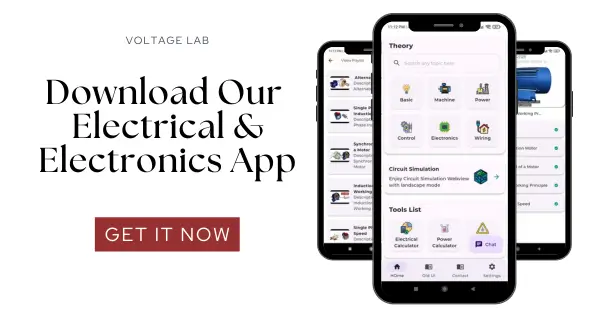Transmission line is a crucial for the efficient distribution of electrical power across vast distances. This article delves into the key components of transmission lines, including supports, insulators, and conductors, among others. We will also cover the roles of different types of poles, such as H-type poles, and discuss the importance of grounding and safety measures. Understanding these elements is essential for ensuring reliable and safe power transmission.
Table of Contents
What is Transmission Line?
Transmission line is a type of line that transmits a high amount of generated power from one station to another via conductive wires.
What is a Distribution Line?
The electricity that is transmitted from the transmission line to residential or consumer-level is called a distribution line.
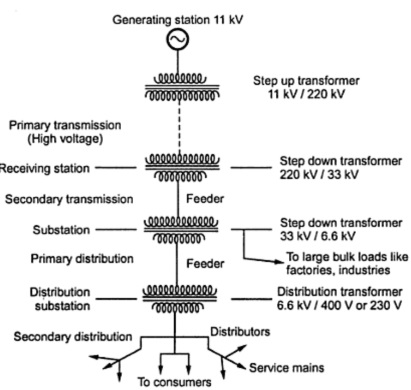
What is Primary Transmission?
The long, extra-high voltage line from the generating station to the receiving end is called primary transmission.
Primary transmission voltage is usually 110kV, 132kV, 230kV, 400kV, or even higher.
What is Secondary Transmission?
The long high-voltage line from the receiving end to the substation is called secondary transmission. Secondary transmission voltage is lower than primary transmission voltage.
Secondary transmission voltage is generally 33kV or 66kV.
What is Secondary Distribution?
The system that reduces the voltage from an 11kV primary distribution line to 400V or 230V using a distribution transformer for various consumer-level electricity supplies in cities, towns, or factories is called secondary distribution.
What is the Best Method for Transmission and Distribution?
The best method for power generation and distribution is the AC system, and for transmission, the DC system is the most efficient.
What is the Maximum Transmission Voltage in Bangladesh?
The maximum transmission voltage in Bangladesh is 400kV, which is located at Bibiyana-Kaliakoir.
What is a Feeder?
A feeder is an un-tapped line constructed from a high voltage substation or grid substation to various load centers for supplying electricity in densely populated, residential, or industrial areas.
What is the Main Difference Between a Feeder and Distribution?
An un-tapped conductor used to supply electricity from a high voltage substation or grid substation to various load centers in densely populated areas is called a feeder.
A conductor with connection tapping to the consumer’s service mains is called a distributor.

What are the Advantages of High Voltage Power Transmission?
- Line losses are reduced.
- Voltage drop along the line is significantly minimized.
- Transmission efficiency increases.
- Less conductor size is required.
- The cost of power transmission is lower.
What Should Be the Percentage Rate of Frequency Fluctuation?
It should be within 2.5%.
What is the Acceptable Maximum Voltage Drop Rate in a Distributor?
6%
What is System Loss?
The overall power loss due to equipment usage at the production center, resistance loss in transmission wires, and other technical losses is called system loss.
What are the Disadvantages of Low Power Factor in the System?
When the power factor is low, larger conductors are required, line losses increase, system efficiency decreases, and costs increase, resulting in a much higher per-unit cost.
What is the Economic Power Factor?
It is a type of power factor that, when improved, results in the maximum annual savings, and is also known as the optimum power factor.
Fundamentals of Electrical Power Transmission and Distribution:
Electrical power transmission and distribution systems are primarily based on three key aspects.
- Power Generation
- Power Transmission
- Power Distribution
First, power is generated. Then, it is transmitted over long distances. Finally, it is made usable and distributed at the consumer level.
The following diagram shows the entire process simply:

- Typically, 11kV is obtained from the power generation site, which is the generation voltage (varies by country).
- This 11kV needs to be transmitted over long distances throughout the country.
- Before transmitting this 11kV power, it is stepped up to 132kV, 230kV, or 400kV for several reasons, and then it is transmitted over long distances.
- Now, if power needs to be connected to various locations, it is stepped down from 132/230/400kV to 11kV.
- If it is a large mill or industrial establishment, the 11kV is directly connected. It is then adjusted or increased to a usable level.
- For residential purposes, the 11kV is stepped down again to 0.44kV or 440V and supplied to homes or small areas.
- From there, it is transformed to 220-240V as needed for use.
Types of Transmission Lines:
Transmission lines are mainly of two types.
- Overhead
- Underground
Overhead Transmission Line: Advantages and Disadvantages:
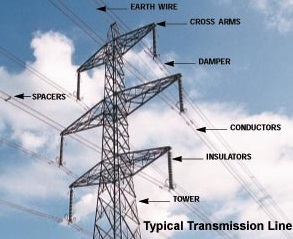
Overhead transmission lines are commonly seen. Especially when traveling or in rural areas, you can see large towers in fields with thick wires attached. This is essentially an overhead transmission line. There are several advantages and disadvantages to this type of line.
Advantages:
- It is safe and feasible to transmit power above 66kV.
- Fault detection in the line is easy.
- Construction and installation costs are much lower.
Disadvantages:
- They occupy a large area.
- If any instrument is damaged or defective, it is costly to repair.
Underground Transmission Line: Advantages and Disadvantages:
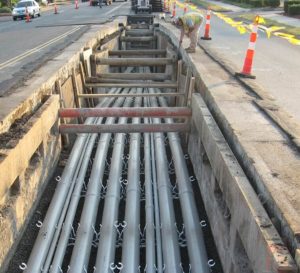
In densely populated or industrial areas, underground transmission lines are used. Below are the advantages and disadvantages of underground lines:
Advantages:
- These lines do not occupy much space.
- They are less likely to be affected by various natural disasters.
- Even if any instrument is damaged or defective, it is much safer and easier to repair than overhead transmission lines.
Disadvantages:
- The installation and maintenance costs of underground lines are high.
- They are mostly used in densely populated areas or industrial sectors.
- It is not cost-effective to use these lines for transmitting power over long distances.
What Components are Present in an Overhead Line?
The following components are generally found in an overhead line.
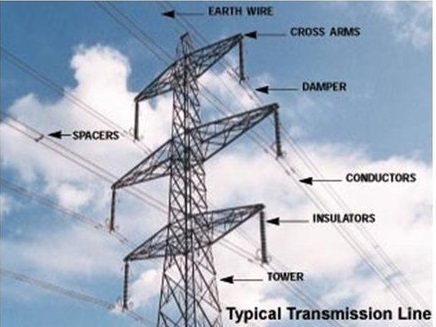
- Support
- Cross-arm and Clamp
- Insulator
- Conductor
- Stay and Guy
- Lightning Arrester
- Guard Wire
- Fuse and Isolating Switch
- Continuous Earth Wire
- Jumper
- Vibration Damper
There are other components as well.
Which Type of Pole Uses a Stay?
A stay is used on angle poles and terminal poles to balance the tension on both sides.
Where is an “H” Type Pole Used?
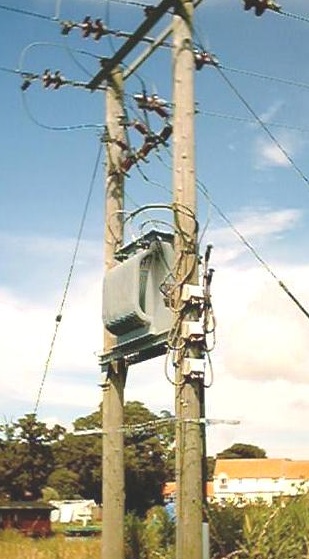
An H type pole is used in 132 kV transmission lines with a long span of up to 160 meters. It is also used in places where switchgear or transformers are required on the line.
Why is a Transmission Line Typically Grounded?
Sometimes, due to lightning or abnormal conditions, insulation breakdown may occur. To protect the line from such incidents, a continuous earth wire is used over the overhead line, allowing excess voltage to discharge into the ground.
Where and Why is a Cradle Guard Used?
A cradle guard is used for safety purposes. It is employed in places where the overhead line crosses roads, railways, or buildings to prevent the conductor from falling to the ground if it breaks.
What Conductors are Used in an Overhead Line?
The conductors used in overhead lines are:
- Steel-Cored Aluminum
- Copper
- Aluminum
- Galvanized Steel Conductor
In special cases, Phosphor Bronze, Copper-Clad Cadmium Copper, etc., are also used.
What Qualities Should Conductors Have in an Overhead Line?
The qualities that conductors should have in an overhead line are:
- Low specific resistance (high electrical conductivity)
- High tensile strength
- Low cost
- The wire should be strong and flexible
- High melting point
- Durability
What is Skin Effect?
When AC electricity flows through a conductor, it tends to flow along the surface rather than through the core. This phenomenon is known as the skin effect. As a result of the skin effect, line resistance increases, leading to higher line losses.
What is Sag?
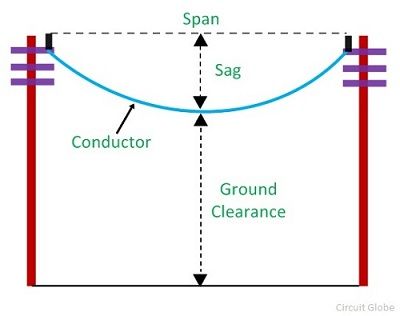
Sag refers to the drooping of a conductor between two poles or towers. When a conductor is installed between two points on poles or towers, it sags slightly. The maximum sag occurs at the lowest point of the conductor compared to the imaginary straight line connecting the two points.
What Happens in a Transmission Line When the Load Power is Very Low?
When the load power is very low, the capacitance effect is generally observed in the line. In this situation, the line carries a 90-degree leading charging current. As a result, the voltage at the receiving end is higher than at the sending end, leading to negative voltage regulation.
Friends, we have already written three articles on power transmission and distribution. Click below to read them.

